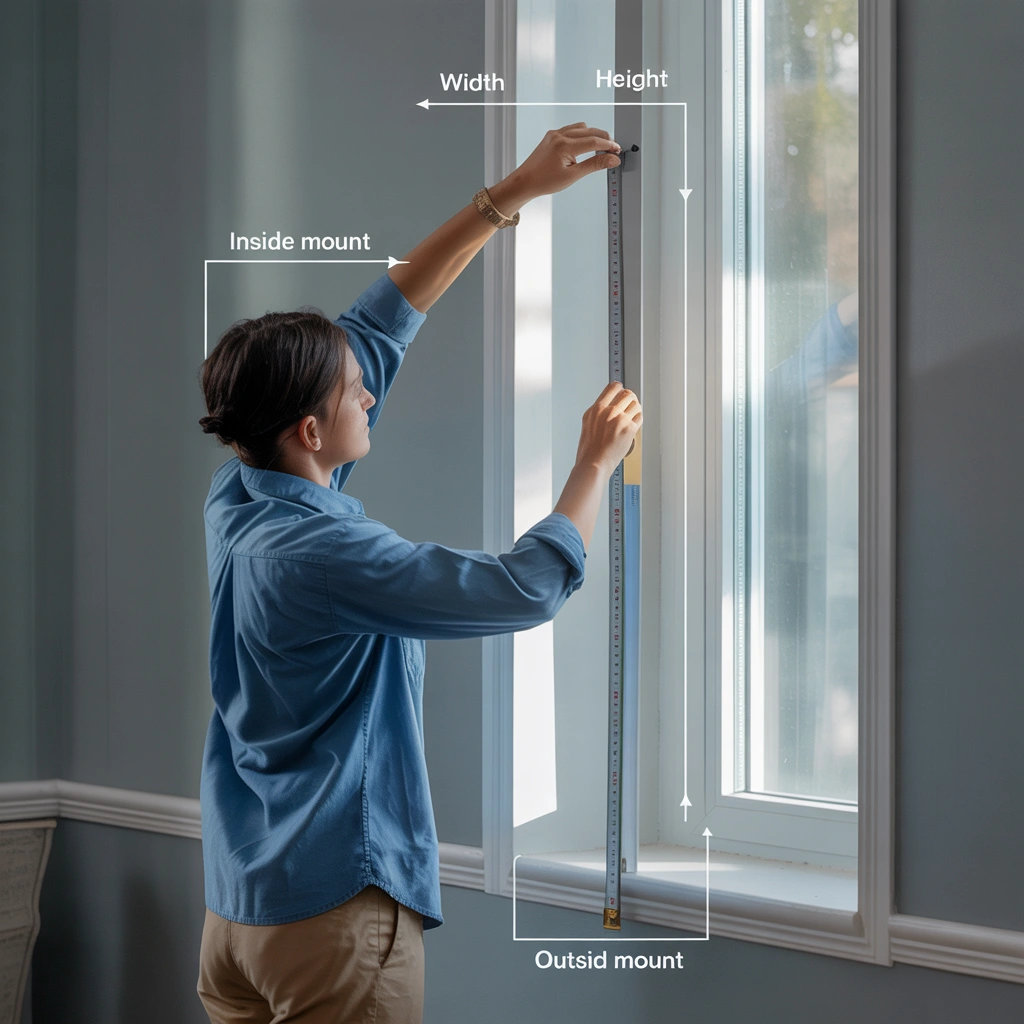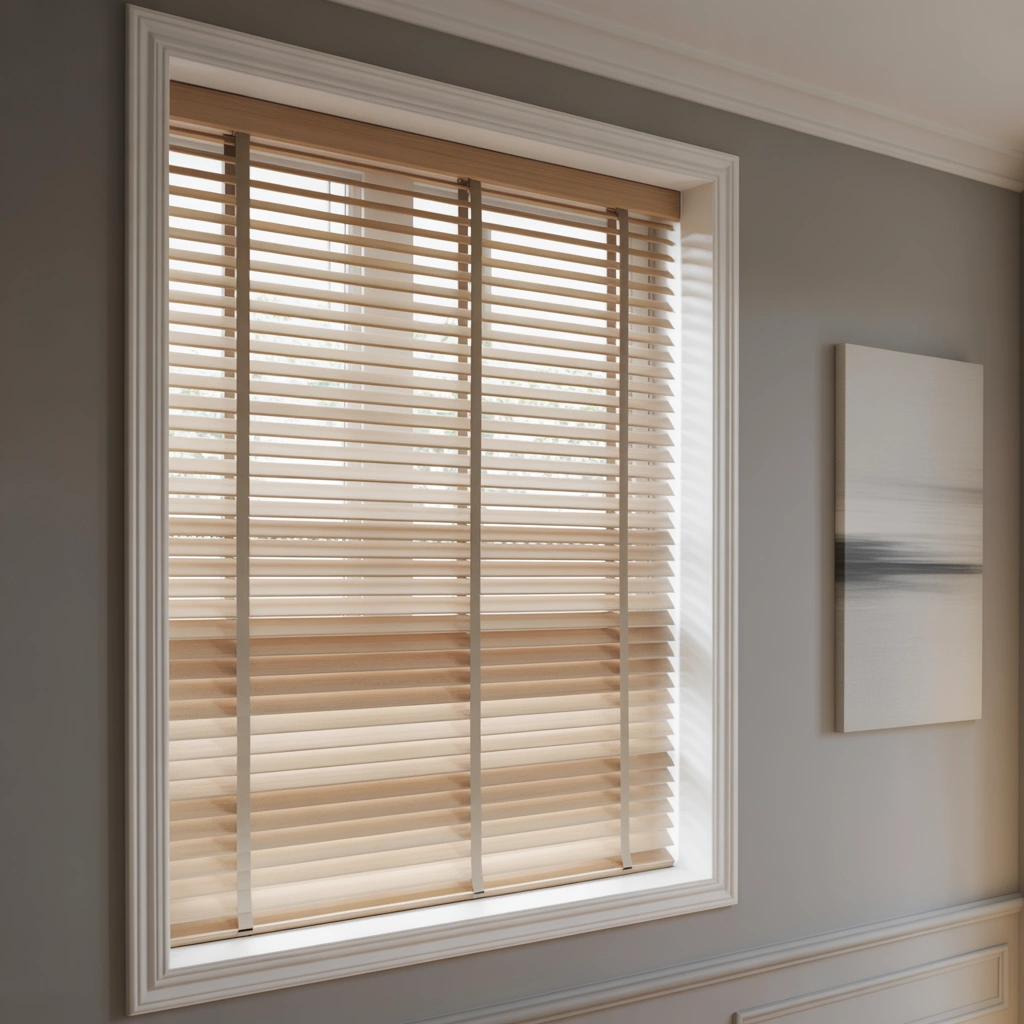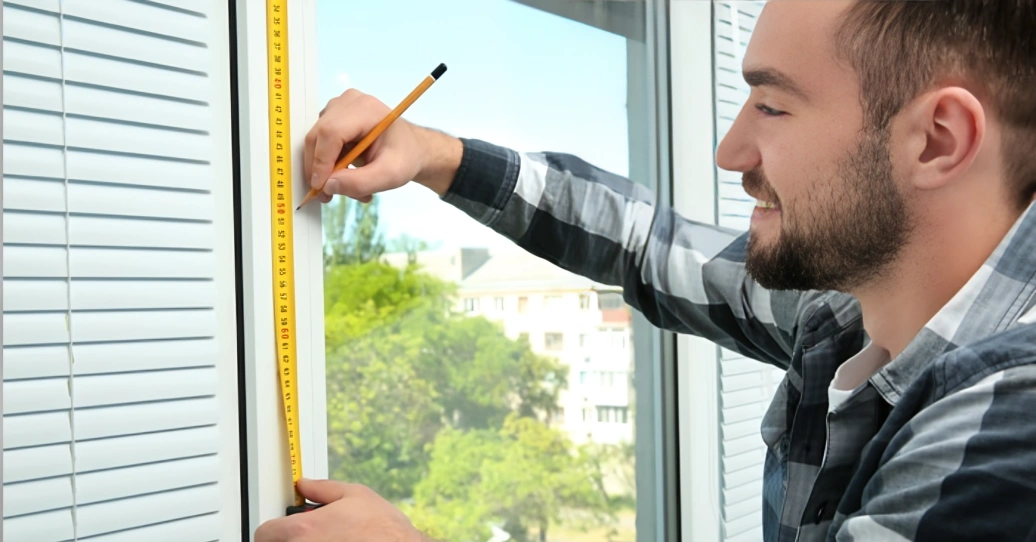When blinds are ordered, they are made to fit the size of your window. If the measurements are wrong, the blinds might not fit. This can waste time and money. By measuring carefully, the blinds will look nice and work well.
Accurate measurements also help avoid gaps where light can sneak in. For example, if an inside mount blind is too small, gaps on the sides will let sunlight through. If it’s too big, it might not close properly. Taking time to measure correctly ensures your blinds do their job—blocking light, adding privacy, and looking great.
If you’re new to blinds, check out our guide on Types of Blinds: Roller vs Venetian vs Vertical to pick the best style for your space.
1. What Tools Do You Need to Measure for Blinds?

Before starting, gather these items:
- Tape measure (metal is better than fabric).
- Pencil and paper to write down numbers.
- Level (optional, but helpful for straight lines).
These tools will make the job easier and more accurate.
Why Use a Metal Tape Measure?
Metal tape measures are stiff and stay straight when stretched. This makes them perfect for measuring windows. Fabric tapes can bend or twist, leading to mistakes.
Why Write Everything Down?
It’s easy to forget numbers if you don’t write them down. Use a notepad to keep track of width, height, and depth measurements. Label each window (e.g., “Kitchen Window”) to avoid confusion.
When to Use a Level
A level helps ensure the blinds hang straight. This is especially important for outside mount blinds, which are visible from the room. If they’re crooked, it will look messy. You may also be wondering: Are Faux Wood Blinds Safe and Durable?
For tips on installing blinds after measuring, read How to Install Blinds Like a Pro.
2. Inside Mount vs Outside Mount: Which One Is Right for You?
What is Inside Mount Blinds?

Inside mount blinds are placed inside the window frame. They look neat and take up less space. They are good for windows with deep frames.
Pros:
- Sleek, built-in look.
- No extra hardware on walls.
- Better light blockage.
Cons:
- Require enough depth (at least 1.5 inches).
- Harder to clean if dust gets stuck in the frame.
What Are Outside Mount Blinds?
Outside mount blinds are attached to the wall or trim above the window. They cover the whole window and are good for shallow frames.
Pros:
- Works for any window type.
- Easier to install.
- It can make small windows look bigger.
Cons:
- Take up more space.
- Need brackets and screws on walls.
If you’re not sure which type is best, read our guide on Roller Blinds vs Venetian vs Vertical Blinds .
3. How to Measure Windows for Inside Mount Blinds — Step by Step
How to Measure the Width of Your Window (Top, Middle, Bottom)?
Three width measurements should be taken: at the top, middle, and bottom of the window. Use the smallest number for the order.
Steps:
- Open the window fully.
- Place the tape measure across the window frame (inside edge to inside edge).
- Measure at three points: top, middle, and bottom.
- Write down each number.
Why take three measurements? Windows are often not perfectly square. Using the smallest width ensures the blind fits without jamming.
How to Measure the Height of Your Window (Left, Center, Right)?
Measure the height on the left, center, and right sides. Pick the longest number to make sure the blinds cover the whole window.
Steps:
- Measure from the top of the window frame to the sill.
- Do this on the left, center, and right sides.
- Use the longest height for your order.
If the window has a sill that sticks out, measure to the bottom of the sill. This avoids gaps at the bottom.
How to Check If Your Window Has Enough Depth for an Inside Mount?
The depth is how far the window frame goes into the wall. Use a ruler to measure this. Most inside mount blinds need at least 1.5 inches of depth.
Steps:
- Place a ruler flat against the window glass.
- Push it into the window frame.
- Measure how far it goes before hitting the frame.
If the depth is less than 1.5 inches, choose an outside mount instead.
4. How to Measure Windows for Outside Mount Blinds — Full Guide
How to Determine the Right Size for Full Coverage?
Add 2–3 inches to the width of the window. This will stop light from leaking in around the edges.
Steps:
- Measure the width of the window (glass area).
- Add 2–3 inches to this number.
- Order blinds with this new width.
Adding extra width ensures the blinds cover the entire window and any gaps in the frame.
Where Should You Mount Outside Blinds?
Decide if the blinds will be attached to the wall or the window trim. Use a level to make sure they are straight.
Steps:
- Hold the blind brackets up to the wall.
- Mark where screws will go.
- Drill holes and attach brackets.
If mounting on trim, ensure the trim is strong enough to hold the blind’s weight.
How Much Overhang Do You Need for Outside Mount Blinds?
An overhang of 2–3 inches on each side is best. This gives full coverage and makes the window look bigger.
Steps:
- Measure the window’s width.
- Add 2–3 inches (1–1.5 inches per side).
- Order blinds with this total width.
For height, add 2–3 inches above and below the window to block light.
5. What Are the Most Common Measurement Mistakes — and How to Avoid Them?
- One measurement only: Always take three width and three height numbers.
- Forgetting the depth: Check if the window is deep enough for inside mounts.
- Using old tools: A broken tape measure can give wrong numbers.
- Rushing the job: Take time to double-check everything.
Mistake 1: Measuring Only Once
Even small errors can cause big problems. Always measure twice! For example, if a window’s width is 30 inches but you measure 29.5 inches, the blind will be too small.
Mistake 2: Ignoring Window Depth
Inside mount blinds need enough space in the frame. If the depth is less than 1.5 inches, the blind won’t fit.
Mistake 3: Using the Wrong Tools
A worn-out tape measure might stretch or have faded numbers. Always use a new, metal tape measure for accuracy.
Mistake 4: Not Leveling the Blinds
Crooked blinds look messy and may not open/close smoothly. Use a level to check alignment before drilling.
6. How to Get the Perfect Fit Whenever Ordering Blinds?
Measuring windows for blinds is not hard if you take your time. Use the right tools, follow the steps, and double-check the numbers. If you’re unsure, ask for help. Once the blinds arrive, enjoy the new look of your room!
For more tips on window treatments, check out our blog on Ripple Fold Curtains vs Pinch Pleat Curtains.
7. Frequently Asked Questions About Measuring for Blinds
Take three width and three height measurements. Use the smallest width and largest height for the order.
Add 2–3 inches to the width and height. This ensures full coverage.
A ruler can work for small windows, but a tape measure is better for most jobs.
It depends on the window. Inside mounts look tidy, while outside mounts cover gaps better.
Very! Even a small mistake can cause big problems. Always double-check.
Odd-shaped windows (like arched or triangular) need custom blinds. Contact a professional for help.
No, the measuring steps are the same for all blind types.

